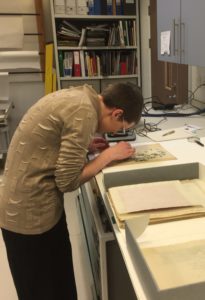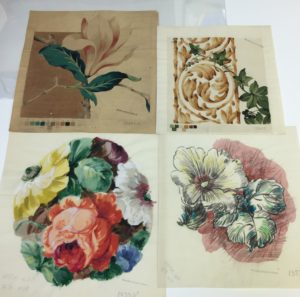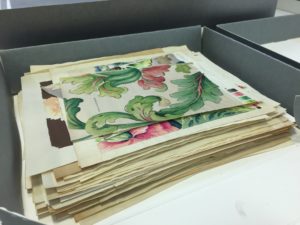Rebekah Harbord: A work placement project
MA Conservation student Rebekah Harbord summarises her work on 1940s designs at MoDA
 As a first-year MA conservation student specialising in art on paper at Camberwell College of Arts, term time placements form a valuable part of our studies. They connect us to the realities of working in the conservation profession.
As a first-year MA conservation student specialising in art on paper at Camberwell College of Arts, term time placements form a valuable part of our studies. They connect us to the realities of working in the conservation profession.
During a four-month period from the end of February to at end of June this year, I worked under the guidance and support of MoDA’s preventive conservator, Emma Shaw. This was the first stage of a project to make over three hundred 1940s designs from the Silver Studio Collection accessible for research and study.
The Silver Studio Collection
The Silver Studio Collection is the legacy of the Silver Studio, a commercial design practice founded in 1880 by Arthur Silver.
The Studio produced an array of designs in a variety of media such as watercolour, gouache and charcoal for domestic furnishing fabrics to wallpapers until the 1960s. The Collection is a popular resource for students, researchers and designers alike with many beautiful floral designs to bold geometric patterns. I was excited to be part of enabling more of this collection to be accessible.
I was excited to be part of enabling more of this collection to be accessible.Working one day a week, my role involved updating catalogue documentation with a description of the materials, and condition and conservation information. I carried out dry surface cleaning and then rehoused each object in a polyester sleeve and then in archival boxes. This will enable safe handling and storage as well as improving the longer-term stability of more fragile drawings on transparent paper, which often suffer from brittleness.
During my time working on the project, I managed to document, clean and rehouse 335 designs. This has increased the number and range of designs that can now able handled by students, researchers and potential licensees. It also enabled an initial snapshot to be taken of Silver Studio designs from the 1940s, in terms of the quantity of transparent paper supports and type of media used.
As the project progresses, I hope this information will enable comparisons across different eras of the Silver Studio Collection to be made with regards to paper type, media usage and perhaps even patterns and colourways, which may provide some interesting information on material availability pre and post war as well as design and colour trends.
A learning opportunity
With a prior interest in transparent papers and design drawings from an earlier career in interior design, this project gave me the opportunity to combine this continued interest with examination of such objects with my new conservation hat on. It was beneficial to examine sensitive media and transparent papers in more detail with the process of updating the documentation for the catalogue giving me the opportunity to expand my understanding of the characteristics of gouache, watercolour and transparent papers and forms of damage.
It also gave fascinating insight into the working processes of generally anonymous designers with some drawings showing evidence of reworking, pencil notes and multiple drawing styles.
Developing professional skills
 Taking ownership over the working processes of the project in discussion with and with support from Emma provided a valuable opportunity to look at conservation from a broader perspective and in the context of a whole collection.
Taking ownership over the working processes of the project in discussion with and with support from Emma provided a valuable opportunity to look at conservation from a broader perspective and in the context of a whole collection.
This is different to assessing the needs and treatment of an individual object in isolation which up until now has been the case during my studies. This has proved a beneficial challenge during which I have considered from a personal perspective how long it takes me to carry out a treatment, how to prioritise my time effectively and the reality of the need to balance treatment with the aims and priorities of a project in the wider context of looking after a collection.
If you are interested in finding out more about these designs, or about conservation work placement opportunities at MoDA, please contact Emma Shaw (e.shaw@mdx.ac.uk).
